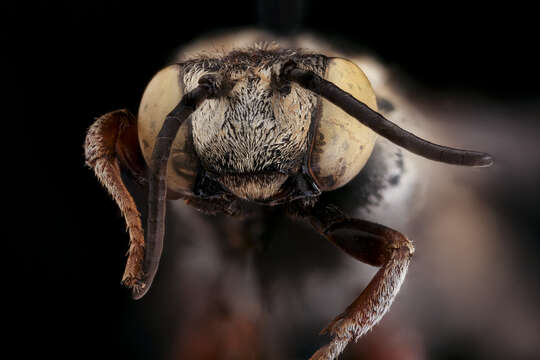Triepeolus subnitens, m, face, Yolo, CA_2019-03-22-02.40.36 ZS PMax UDR

Description:
The Mysterious Triepeolus subnitens. I am not sure why I use the term "mysterious" here as almost all bee species (yes even honey bees) are mysterious. But parasitic bees are considered particularly mysterious. First we should point out that they make up about 20% of the entire bee fauna. Second, as nest parasites, they are de facto less common than their hosts and therefore generally rare. Third, people have a super hard time finding the nests of most bee species and consequently, we have fewer specimens to look at for groups like Triepeolus and a devil of a time really determining who they parasitize with 100% confidence. For example, our friend, T. subnitens is said to parasitize Svastra obliqua, but only based on someone seeing a T.s. go into a S.o. nest hole (side note: Most Triepeolus parasitize Melissodes). That's it, sample size 1 + circumstantial evidence (maybe it was just checking the nest out, for example). This lack of understanding of something so fundamental irritates me, particularly when so many people play Tennis. Just think of how much more we would know if everyone now play Tennis instead looked for bee nests and their parasites. Head spinning. Photo by beelab tech Erick Hernandez. "This bee was collected in the California Central Valley in Yolo County for research on small-scale restoration in agricultural areas. Claire Kremen's 10-year study of hedgerows shows the benefits of planting native shrubs and forbs in agricultural areas for native bees. To learn more about the Kremen Lab and hedgerows." ~~~~~~~~~~{{{{{{0}}}}}}~~~~~~~~~~ All photographs are public domain, feel free to download and use as you wish. Photography Information: Canon Mark II 5D, Zerene Stacker, Stackshot Sled, 65mm Canon MP-E 1-5X macro lens, Twin Macro Flash in Styrofoam Cooler, F5.0, ISO 100, Shutter Speed 200 We Are Made One with What We Touch and See We are resolved into the supreme air, We are made one with what we touch and see, With our heart's blood each crimson sun is fair, With our young lives each spring impassioned tree Flames into green, the wildest beasts that range The moor our kinsmen are, all life is one, and all is change. - Oscar Wilde You can also follow us on Instagram - account = USGSBIML Want some Useful Links to the Techniques We Use? Well now here you go Citizen: Best over all technical resource for photo stacking: www.extreme-macro.co.uk/ Art Photo Book: Bees: An Up-Close Look at Pollinators Around the World: www.amazon.com/Bees-Up-Close-Pollinators-Around-World/dp/... Free Field Guide to Bee Genera of Maryland: bio2.elmira.edu/fieldbio/beesofmarylandbookversion1.pdf Basic USGSBIML set up: www.youtube.com/watch?v=S-_yvIsucOY USGSBIML Photoshopping Technique: Note that we now have added using the burn tool at 50% opacity set to shadows to clean up the halos that bleed into the black background from "hot" color sections of the picture. www.youtube.com/watch?v=Bdmx_8zqvN4 Bees of Maryland Organized by Taxa with information on each Genus www.flickr.com/photos/usgsbiml/collections PDF of Basic USGSBIML Photography Set Up: Google Hangout Demonstration of Techniques: plus.google.com/events/c5569losvskrv2nu606ltof8odo or www.youtube.com/watch?v=4c15neFttoU Excellent Technical Form on Stacking: www.photomacrography.net/ Contact information: Sam Droege sdroege@usgs.gov 301 497 5840
Included On The Following Pages:
- Life (creatures)
- Cellular (cellular organisms)
- Eukaryota (eukaryotes)
- Opisthokonta (opisthokonts)
- Metazoa (Animal)
- Bilateria
- Protostomia (protostomes)
- Ecdysozoa (ecdysozoans)
- Arthropoda (arthropods)
- Pancrustacea
- Hexapoda (hexapods)
- Insecta (insects)
- Pterygota (winged insects)
- Neoptera (neopteran)
- Endopterygota (endopterygotes)
- Hymenoptera (wasps, bees, and ants)
- Apocrita (wasp)
- Aculeata
- Apoidea (bees & apoid Wasps)
- Anthophila (bee)
- Apidae (honeybees, bumblebees, and relatives)
- Nomadinae (cuckoo bee)
- Epeolini
- Triepeolus
- Triepeolus subnitens
This image is not featured in any collections.
Source Information
- license
- cc-publicdomain
- copyright
- USGS Bee Inventory and Monitoring Lab
- photographer
- USGS Bee Inventory and Monitoring Lab
- original
- original media file
- visit source
- partner site
- USGS Bee Inventory and Monitoring Lab
- ID


